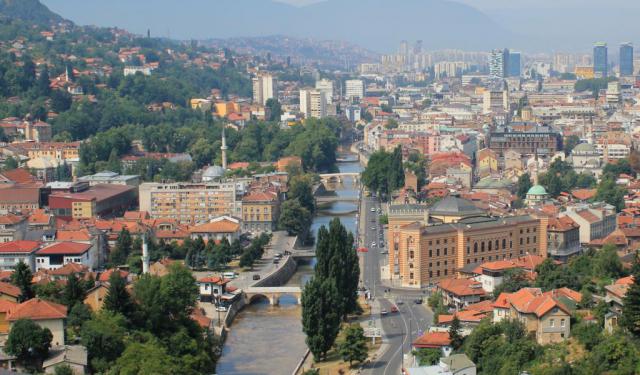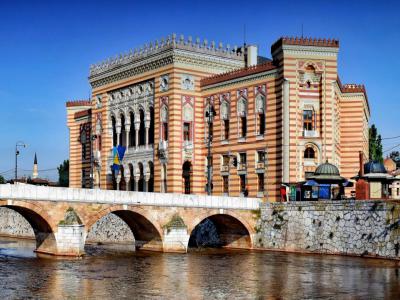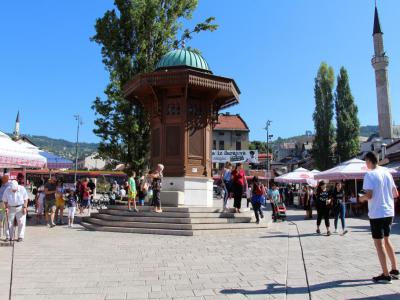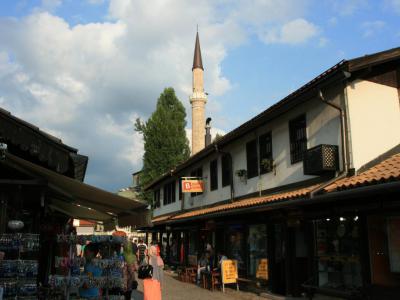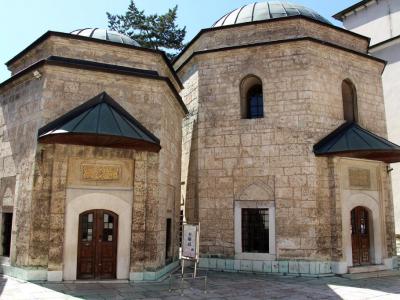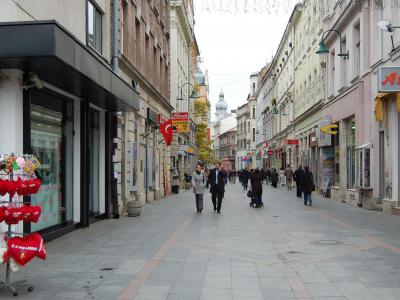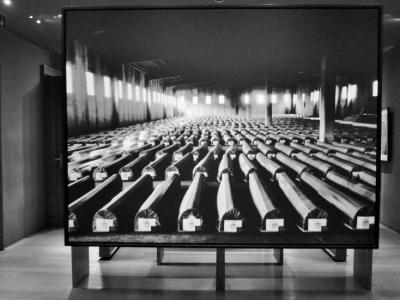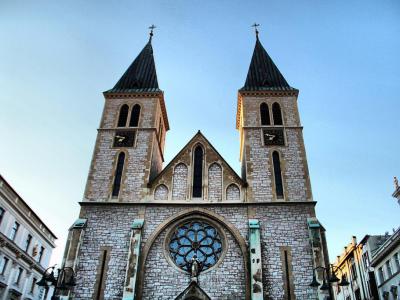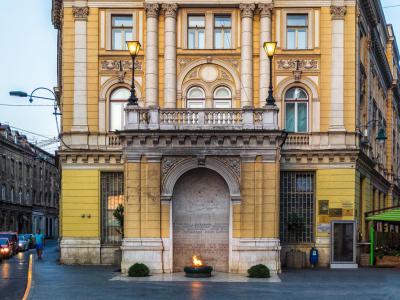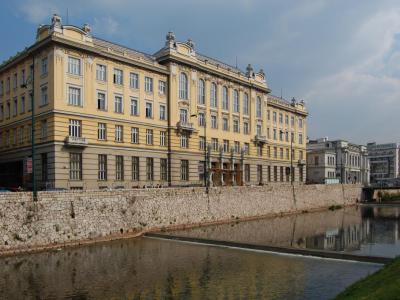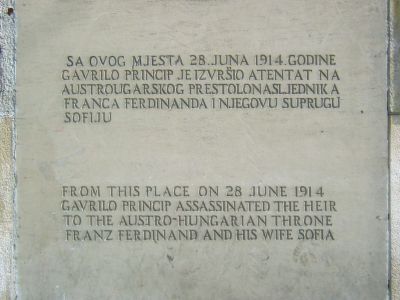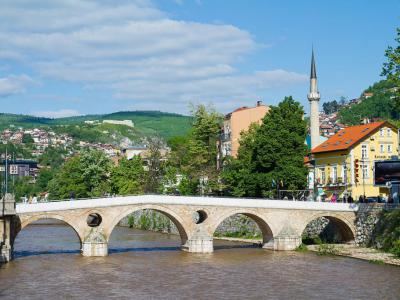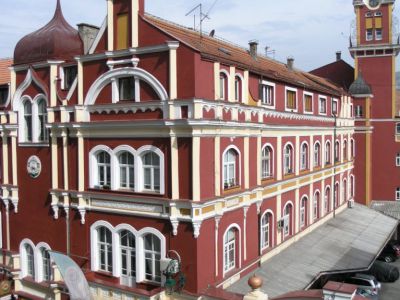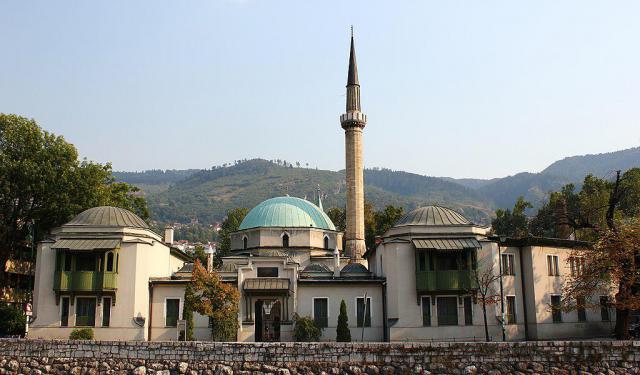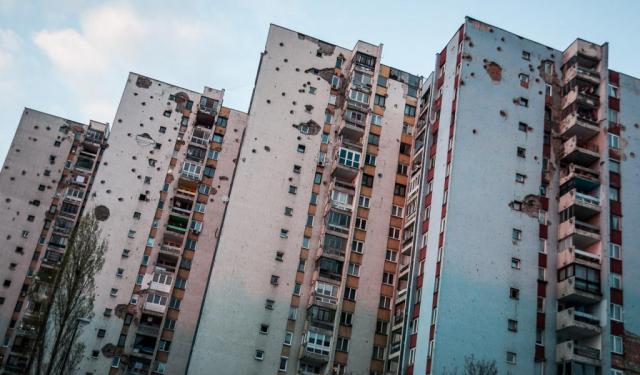Sarajevo Introduction Walking Tour (Self Guided), Sarajevo
Sarajevo is the capital of Bosnia and Herzegovina. It is also the country's largest city. This historical and picturesque city is surrounded by the Dinaric Alps and rests along both banks of the Miljacka River.
The city was established by the Ottoman Empire around 1461. It was named "Sarajevo," which means "the plains around the palace." The name is derived from the construction of the governor's castle and new buildings, including the Emperor's Mosque, an enclosed marketplace, and a public bathhouse.
By the 16th century, Sarajevo was known as a place where many cultures could unite. As Jews were expelled from Spain, they were welcomed in Sarajevo. Likewise, more than 100 mosques popped up in the city to serve the area's growing Muslim population.
The Great Turkish War in 1697 led to the destruction of the city. Uprisings continued until eventually the region was occupied by Austria-Hungary in 1878. While there was still conflict in the city, it also became an area of significant industrialization as engineers and architects tested new inventions while the city was being rebuilt. For example, Sarajevo was the testing area for tramways, and the Gazi Husrev-beg Mosque was the first mosque to have electricity and indoor lighting.
Sarajevo is widely known as the location of the assassination of Archduke Franz Ferdinand and his wife, Sofie. This event, which marked the beginning of World War I, took place at the northern end of the Latin Bridge.
After the war ended, Sarajevo joined Yugoslavia. The Bosnian War for Independence took place from 1992 to 1996, after which Bosnia and Herzegovina declared independence from the former Yugoslavia.
Visitors to the city will see reminders of this complex history throughout Sarajevo. The Gazi Husrev-beg Mosque, the Cathedral of Jesus' Heart, and the historical Sarajevo Brewery show how the changes that have taken place in Sarajevo have shaped the culture and architecture of the region.
Take this self-guided tour to explore the most notable attractions in Sarajevo.
The city was established by the Ottoman Empire around 1461. It was named "Sarajevo," which means "the plains around the palace." The name is derived from the construction of the governor's castle and new buildings, including the Emperor's Mosque, an enclosed marketplace, and a public bathhouse.
By the 16th century, Sarajevo was known as a place where many cultures could unite. As Jews were expelled from Spain, they were welcomed in Sarajevo. Likewise, more than 100 mosques popped up in the city to serve the area's growing Muslim population.
The Great Turkish War in 1697 led to the destruction of the city. Uprisings continued until eventually the region was occupied by Austria-Hungary in 1878. While there was still conflict in the city, it also became an area of significant industrialization as engineers and architects tested new inventions while the city was being rebuilt. For example, Sarajevo was the testing area for tramways, and the Gazi Husrev-beg Mosque was the first mosque to have electricity and indoor lighting.
Sarajevo is widely known as the location of the assassination of Archduke Franz Ferdinand and his wife, Sofie. This event, which marked the beginning of World War I, took place at the northern end of the Latin Bridge.
After the war ended, Sarajevo joined Yugoslavia. The Bosnian War for Independence took place from 1992 to 1996, after which Bosnia and Herzegovina declared independence from the former Yugoslavia.
Visitors to the city will see reminders of this complex history throughout Sarajevo. The Gazi Husrev-beg Mosque, the Cathedral of Jesus' Heart, and the historical Sarajevo Brewery show how the changes that have taken place in Sarajevo have shaped the culture and architecture of the region.
Take this self-guided tour to explore the most notable attractions in Sarajevo.
How it works: Download the app "GPSmyCity: Walks in 1K+ Cities" from Apple App Store or Google Play Store to your mobile phone or tablet. The app turns your mobile device into a personal tour guide and its built-in GPS navigation functions guide you from one tour stop to next. The app works offline, so no data plan is needed when traveling abroad.
Sarajevo Introduction Walking Tour Map
Guide Name: Sarajevo Introduction Walking Tour
Guide Location: Bosnia-Herzegovina » Sarajevo (See other walking tours in Sarajevo)
Guide Type: Self-guided Walking Tour (Sightseeing)
# of Attractions: 12
Tour Duration: 2 Hour(s)
Travel Distance: 2.7 Km or 1.7 Miles
Author: DanaOffice
Sight(s) Featured in This Guide:
Guide Location: Bosnia-Herzegovina » Sarajevo (See other walking tours in Sarajevo)
Guide Type: Self-guided Walking Tour (Sightseeing)
# of Attractions: 12
Tour Duration: 2 Hour(s)
Travel Distance: 2.7 Km or 1.7 Miles
Author: DanaOffice
Sight(s) Featured in This Guide:
- Sarajevo City Hall
- Baščaršija (Old Bazaar) and Sebilj Fountain
- Sarači Street
- Gazi Husrev-beg Mosque
- Ferhadija Street
- Gallery 11/07/95
- Cathedral of Jesus' Heart
- Eternal Flame
- Central Post Office
- Sarajevo Assassination Memorial Plaque
- Latin Bridge
- Sarajevska Pivara (Sarajevo Brewery)
1) Sarajevo City Hall (must see)
Sarajevo City Hall, known as Vijecnica, is a symbol of Sarajevo and one of the most beautiful monuments from the Austro-Hungarian period. It is the seat and headquarters of the Mayor of Sarajevo and the Sarajevo City Council. The building has been used for various municipal purposes since its construction, including as a City Court and Parliament House until 1949, when it became the National and University Library of Bosnia and Herzegovina, through the late 20th century.
Construction of the City Hall began in 1891 and was completed in 1896. It was first designed by Czech architect Karel Parik. After he was removed from the job by Baron Beni Kallay, the Austrian-Hungarian architect Alexander Wittek took over. Wittek died before the construction could be completed, so Ciril Ivekovic, a Croatian architect, finished the project. The building was inspired by Spanish and Northern Africa Islamic art.
The City Hall was destroyed in 1992 during the Siege of Sarajevo. About 700 manuscripts, including unique publications, were lost. Reconstruction of the building began in 1996 and was completed in 2014. Since its reopening, the space has been used as an exhibition hall, a concert venue, and the National Library. It is now considered a National Monument of Bosnia and Herzegovina.
Construction of the City Hall began in 1891 and was completed in 1896. It was first designed by Czech architect Karel Parik. After he was removed from the job by Baron Beni Kallay, the Austrian-Hungarian architect Alexander Wittek took over. Wittek died before the construction could be completed, so Ciril Ivekovic, a Croatian architect, finished the project. The building was inspired by Spanish and Northern Africa Islamic art.
The City Hall was destroyed in 1992 during the Siege of Sarajevo. About 700 manuscripts, including unique publications, were lost. Reconstruction of the building began in 1996 and was completed in 2014. Since its reopening, the space has been used as an exhibition hall, a concert venue, and the National Library. It is now considered a National Monument of Bosnia and Herzegovina.
2) Baščaršija (Old Bazaar) and Sebilj Fountain (must see)
The Old Bazaar (Bascarsija) is the historical and cultural center of Sarajevo. It was built by Isa-Bey Ishakovic, the founder of Sarajevo, at the time the city was founded in the 15th century.
The first construction of the Old Bazaar was in 1462. An inn and several shops were built in the area. Mosques were also added, including the Gazi Husrev-beg Mosque, which was constructed in 1530. In addition to the Mosques, the Old Orthodox Church was established around 1539, and the Old Synagogue was built in 1587.
There are many important, historical buildings and structures in and around the Old Bazaar. Among these are the Gazi Husrev-beg Mosque and the Sebilj Fountain.
Sebilj Fountain is a symbol of Sarajevo. The Ottoman-style wooden fountain built by Mehmed Pasha Kukavica in 1753, was relocated by Austrian architect Alexander Wittek in 1891. Legend states that anyone who drinks from the Sebilj Fountain will return to Sarajevo.
The fountain is so famous that it has inspired numerous replicas around the world. There are copies of the Sebilj Fountain in Belgrade, Serbia; Saint Louis, Missouri; Bursa, Turkey; and Rozaje, Montenegro.
The first construction of the Old Bazaar was in 1462. An inn and several shops were built in the area. Mosques were also added, including the Gazi Husrev-beg Mosque, which was constructed in 1530. In addition to the Mosques, the Old Orthodox Church was established around 1539, and the Old Synagogue was built in 1587.
There are many important, historical buildings and structures in and around the Old Bazaar. Among these are the Gazi Husrev-beg Mosque and the Sebilj Fountain.
Sebilj Fountain is a symbol of Sarajevo. The Ottoman-style wooden fountain built by Mehmed Pasha Kukavica in 1753, was relocated by Austrian architect Alexander Wittek in 1891. Legend states that anyone who drinks from the Sebilj Fountain will return to Sarajevo.
The fountain is so famous that it has inspired numerous replicas around the world. There are copies of the Sebilj Fountain in Belgrade, Serbia; Saint Louis, Missouri; Bursa, Turkey; and Rozaje, Montenegro.
3) Sarači Street
Saraci Street, formerly known as Petar II Karadordevic Street, is one of the main pedestrian streets in Sarajevo. The street runs east to west from Bascarsija (Old Bazaar) to Ferhadija Street, respectively.
The pedestrian street is known for its shops that sell traditional handicrafts. Visitors can shop for jewelry, candy, books, accessories, and perfumes. They can even stop at a gallery to appreciate local art.
There are numerous places for tourists to stop to have coffee, drinks, and Bosnian baked goods. Visitors can try falafel or kebab at an indoor restaurant or at one of the open-air tables.
Saraci is also known for its historic buildings. Some of these are the Gazi Husrev-beg Mosque and Museum; and the Morica Han.
The street gains its name from the Turkish word "sarach," which refers to saddlemakers. Having existed since 1462, it was one of the first-named streets in the city. Sarači Street was declared a National Monument of Bosnia and Herzegovina in 2014.
The pedestrian street is known for its shops that sell traditional handicrafts. Visitors can shop for jewelry, candy, books, accessories, and perfumes. They can even stop at a gallery to appreciate local art.
There are numerous places for tourists to stop to have coffee, drinks, and Bosnian baked goods. Visitors can try falafel or kebab at an indoor restaurant or at one of the open-air tables.
Saraci is also known for its historic buildings. Some of these are the Gazi Husrev-beg Mosque and Museum; and the Morica Han.
The street gains its name from the Turkish word "sarach," which refers to saddlemakers. Having existed since 1462, it was one of the first-named streets in the city. Sarači Street was declared a National Monument of Bosnia and Herzegovina in 2014.
4) Gazi Husrev-beg Mosque (must see)
Gazi Husrev-beg Mosque is a Sunni Islam mosque in the historic center of Sarajevo. This 16th-century mosque was designed by architect Acem Esir Ali using Early Period, Classical Ottoman architecture. Construction was completed in 1530. Along with the mosque, the plans included Islamic primary and secondary schools, a public bath, and a marketplace.
The mosque was retrofitted with electricity and indoor lighting in 1898 under the Austro-Hungarian Empire. It was the first mosque in the world to have these modern conveniences.
The mosque was targeted by Serbians during the Siege of Sarajevo. It suffered major destruction, but reconstruction efforts began almost immediately at the end of the siege. The new interior was designed by contemporary Bosnian calligrapher Hazim Numanagic.
Gazi Husrev-beg Mosque is considered the largest historical mosque in the country. It is also one of the city's most popular tourist attractions. Visitors are welcome to tour the mosque and its museum daily from 9 AM to 7 PM.
The mosque was retrofitted with electricity and indoor lighting in 1898 under the Austro-Hungarian Empire. It was the first mosque in the world to have these modern conveniences.
The mosque was targeted by Serbians during the Siege of Sarajevo. It suffered major destruction, but reconstruction efforts began almost immediately at the end of the siege. The new interior was designed by contemporary Bosnian calligrapher Hazim Numanagic.
Gazi Husrev-beg Mosque is considered the largest historical mosque in the country. It is also one of the city's most popular tourist attractions. Visitors are welcome to tour the mosque and its museum daily from 9 AM to 7 PM.
5) Ferhadija Street
Ferhadija Street is one of the primary pedestrian streets in Sarajevo. It runs east to west from Saraci Street to Marshal Tito Street. It is known as the home to several important buildings and structures, making it a favorite street for tourists.
Some of the significant places on Ferhadija Street are Sarajevo Market hall, Sacred Heart Cathedral, the Ferhadija Mosque, and multiple foreign embassies. Ferhadija Street is also home to the Eternal Flame, a memorial to military and civilian casualties in World War II.
The street provides easy access to shopping and dining establishments. Outdoor art proliferates the street, especially in the form of graffiti. Visitors can find street vendors selling souvenirs from carts outside, featuring the most popular tourist locations. Ferhadija Street also offers easy access to the Museum of Crimes Against Humanity and Genocide.
Ferhadija Street was named after the Ferhadija Mosque, built by Ferhad-bey Vukovic-Desisalic, governor during Ottoman rule in the 16th century. It was renamed twice. Once from 1928 to 1941 after King Peter II Karadjordjevic and again from 1945 to 1993 after Yugoslavian hero Vaso Miskin Crni. Since 1993, the old name Ferhadija has been restored.
Some of the significant places on Ferhadija Street are Sarajevo Market hall, Sacred Heart Cathedral, the Ferhadija Mosque, and multiple foreign embassies. Ferhadija Street is also home to the Eternal Flame, a memorial to military and civilian casualties in World War II.
The street provides easy access to shopping and dining establishments. Outdoor art proliferates the street, especially in the form of graffiti. Visitors can find street vendors selling souvenirs from carts outside, featuring the most popular tourist locations. Ferhadija Street also offers easy access to the Museum of Crimes Against Humanity and Genocide.
Ferhadija Street was named after the Ferhadija Mosque, built by Ferhad-bey Vukovic-Desisalic, governor during Ottoman rule in the 16th century. It was renamed twice. Once from 1928 to 1941 after King Peter II Karadjordjevic and again from 1945 to 1993 after Yugoslavian hero Vaso Miskin Crni. Since 1993, the old name Ferhadija has been restored.
6) Gallery 11/07/95 (must see)
Gallery 11/07/95 is an art gallery that honors the 8,372 people killed in the Srebrenica genocide. The memorial art gallery was established in 2012 by photographer Tarik Samarah and the Governments of Turkey and Sarajevo Canton.
The goal of Gallery 11/07/95 is to decry the horrors of wars and violence while also reminding the world of the Srebrenica genocide. Srebrenica, the small mountain town in the eastern part of Republika Srpska, an entity of Bosnia and Herzegovina, was declared under the United Nations' protection. Approximately 40,000 Muslim refugees have been placed in Srebrenica, during the Bosnian War.
Though Srebrenica was under protection, it was still targeted by the Army of Republika Srpska. A military operation called Krivaja 95 resulted in the murder of over 8,000 Bosnian Muslim men, women, and children. Gallery 11/07/95 seeks to give voice to those whose life were lost.
There are approximately 10,000 items in the Gallery 11/07/95 collection. The permanent exhibits feature archival material from Srebrenica. Materials include images, maps, videos, and audio from the genocide, which occurred in July 1995.
Portraits of victims are part of the permanent exhibit. There are more than 600 personal photos collected of those who were killed. The Wall of Death displays the names of all those who have been identified. There is also an interactive area called "Mapping Genocide" and a memorial film directed by documentarian Leslie Woodhead.
The gallery's temporary exhibits feature works from artists, photographers, and photojournalists. Some of the artists who have had work displayed at Gallery 11/07/95 include Narciso Contreras, Ron Haviv, Luc Delahaye, Manuel Rivera-Ortiz, and Michelangelo Pistoletto. Some of these temporary exhibits have featured postcards from Sarajevo, anti-Masonic posters, war journals, and photographs from the Siege of Sarajevo.
The goal of Gallery 11/07/95 is to decry the horrors of wars and violence while also reminding the world of the Srebrenica genocide. Srebrenica, the small mountain town in the eastern part of Republika Srpska, an entity of Bosnia and Herzegovina, was declared under the United Nations' protection. Approximately 40,000 Muslim refugees have been placed in Srebrenica, during the Bosnian War.
Though Srebrenica was under protection, it was still targeted by the Army of Republika Srpska. A military operation called Krivaja 95 resulted in the murder of over 8,000 Bosnian Muslim men, women, and children. Gallery 11/07/95 seeks to give voice to those whose life were lost.
There are approximately 10,000 items in the Gallery 11/07/95 collection. The permanent exhibits feature archival material from Srebrenica. Materials include images, maps, videos, and audio from the genocide, which occurred in July 1995.
Portraits of victims are part of the permanent exhibit. There are more than 600 personal photos collected of those who were killed. The Wall of Death displays the names of all those who have been identified. There is also an interactive area called "Mapping Genocide" and a memorial film directed by documentarian Leslie Woodhead.
The gallery's temporary exhibits feature works from artists, photographers, and photojournalists. Some of the artists who have had work displayed at Gallery 11/07/95 include Narciso Contreras, Ron Haviv, Luc Delahaye, Manuel Rivera-Ortiz, and Michelangelo Pistoletto. Some of these temporary exhibits have featured postcards from Sarajevo, anti-Masonic posters, war journals, and photographs from the Siege of Sarajevo.
7) Cathedral of Jesus' Heart
The Cathedral of Jesus' Heart is a Roman Catholic Cathedral in the historic center of Sarajevo. The 19th-century building goes by many names. Some refer to it as the Sacred Heart Cathedral, Sarajevo Cathedral, or the Cathedral of Jesus' Sacred Heart. It is the archdiocese of Vrhbosna, a small region in today's central Bosnia and Herzegovina.
The Cathedral was constructed between 1884 and 1887 and was consecrated in 1889. Architects Josip Vancas and Baron Karl Schwarz designed the Cathedral of Jesus' Heart in the Neo-Gothic architectural style with Romanesque Revival influences. It was modeled after Notre Dame in Dijon, France.
The religious edifice, which is the largest in Bosnia and Herzegovina, has two bell spires with six bells. On the main building, between the spires, is a rosette and a statue of the Sacred Heart. Inside, the Cathedral has a marble altar designed by Josip Vancas and side altars dedicated to the Immaculate Conception and the apostles of the Slavs.
The Siege of Sarajevo caused some damage to the structure. Unlike many of the other buildings in the city, the Cathedral was not destroyed. It was repaired and continued to host services.
The Cathedral was constructed between 1884 and 1887 and was consecrated in 1889. Architects Josip Vancas and Baron Karl Schwarz designed the Cathedral of Jesus' Heart in the Neo-Gothic architectural style with Romanesque Revival influences. It was modeled after Notre Dame in Dijon, France.
The religious edifice, which is the largest in Bosnia and Herzegovina, has two bell spires with six bells. On the main building, between the spires, is a rosette and a statue of the Sacred Heart. Inside, the Cathedral has a marble altar designed by Josip Vancas and side altars dedicated to the Immaculate Conception and the apostles of the Slavs.
The Siege of Sarajevo caused some damage to the structure. Unlike many of the other buildings in the city, the Cathedral was not destroyed. It was repaired and continued to host services.
8) Eternal Flame
The Eternal Flame is a memorial to military and civilian casualties of World War II. It is located in the historic center of Sarajevo at the intersection of Ferhadija Street and Marshal Tito Street.
The memorial was designed by architect Juraj Neidhardt. It was dedicated in 1946 to the anniversary of the liberation of Sarajevo from Nazi Germany.
The memorial appears as a gate with an arched doorway. In front of the memorial is an eternal flame. Inside, a cemented plaque is inscribed in Bosnian with the following:
"With courage and the jointly spilled blood of the fighters of the Bosnian-Herzegovinian, Croatian, Montenegrin, and Serbian brigades of the glorious Yugoslav Army; with the joint efforts and sacrifices of Sarajevan patriots Serbs, Muslims and Croats on 6 April 1945 Sarajevo, the capital city of the People's Republic of Bosnia and Herzegovina was liberated. Eternal glory and gratitude to the fallen heroes for the liberation of Sarajevo and our homeland on the first anniversary of its liberation - a grateful Sarajevo."
The memorial was designed by architect Juraj Neidhardt. It was dedicated in 1946 to the anniversary of the liberation of Sarajevo from Nazi Germany.
The memorial appears as a gate with an arched doorway. In front of the memorial is an eternal flame. Inside, a cemented plaque is inscribed in Bosnian with the following:
"With courage and the jointly spilled blood of the fighters of the Bosnian-Herzegovinian, Croatian, Montenegrin, and Serbian brigades of the glorious Yugoslav Army; with the joint efforts and sacrifices of Sarajevan patriots Serbs, Muslims and Croats on 6 April 1945 Sarajevo, the capital city of the People's Republic of Bosnia and Herzegovina was liberated. Eternal glory and gratitude to the fallen heroes for the liberation of Sarajevo and our homeland on the first anniversary of its liberation - a grateful Sarajevo."
9) Central Post Office
The Central Post Office was the primary postal service building in Bosnia and Herzegovina. It was designed by architect Josip Vancas in 1911. Built in the Neoclassical architectural style, it was based on Postsparkasse, the Viennese Postal Savings Office. The Central Post Office officially opened in 1913.
The building was greatly damaged by the Yugoslav National army in 1992. Like many buildings in Sarajevo, the Central Post Office was engulfed in flames. It remained in ruins for many years but was restored in 2001. The interior glass ceiling, chandeliers, and brass counters were all replaced or refurbished to mirror what it looked like when it was first built nearly 100 years earlier.
While the post office was in ruins, it served as a reminder of the war. It was even used as the backdrop for a performance of Moliere's play "Tartuffe" in 1997. Today, the Central Post Office once again functions as a government-run postal center.
The building was greatly damaged by the Yugoslav National army in 1992. Like many buildings in Sarajevo, the Central Post Office was engulfed in flames. It remained in ruins for many years but was restored in 2001. The interior glass ceiling, chandeliers, and brass counters were all replaced or refurbished to mirror what it looked like when it was first built nearly 100 years earlier.
While the post office was in ruins, it served as a reminder of the war. It was even used as the backdrop for a performance of Moliere's play "Tartuffe" in 1997. Today, the Central Post Office once again functions as a government-run postal center.
10) Sarajevo Assassination Memorial Plaque
The Assassination Memorial Plaque in Sarajevo marks one of the most significant turning points in modern history. On June 28, 1914, Archduke Franz Ferdinand of Austria and his wife, Sophie, Duchess of Hohenberg, were shot and killed here by Gavrilo Princip, a young Bosnian Serb nationalist. Princip was linked to revolutionary groups seeking independence from Austro-Hungarian rule, and his act was intended as a strike against imperial authority.
The assassination reverberated far beyond the Balkans. Within weeks, Austria-Hungary declared war on Serbia, igniting a chain reaction of alliances and hostilities that escalated into World War I. What began as a local act of political violence in Sarajevo soon engulfed Europe and much of the world in unprecedented conflict, making this site a key reference point in the narrative of the 20th century.
The plaque itself has a layered history. First installed in 1915 by the Austro-Hungarian authorities, it was later removed after World War I when Sarajevo became part of the Kingdom of Yugoslavia. During the communist period, it was reinstated and has remained in place since then. Today, visitors can find it mounted on the wall at the exact spot where Princip fired the fatal shots.
Simple in design, the rectangular stone tablet bears an inscription in both Serbian and English: “FROM THIS PLACE ON JUNE 28 1914 GAVRILO PRINCIP ASSASSINATED THE HEIR TO THE AUSTRO-HUNGARIAN THRONE FRANZ FERDINAND AND HIS WIFE SOPHIA.” More than a local landmark, it stands as a sober reminder of how a single moment in Sarajevo altered the course of world history.
The assassination reverberated far beyond the Balkans. Within weeks, Austria-Hungary declared war on Serbia, igniting a chain reaction of alliances and hostilities that escalated into World War I. What began as a local act of political violence in Sarajevo soon engulfed Europe and much of the world in unprecedented conflict, making this site a key reference point in the narrative of the 20th century.
The plaque itself has a layered history. First installed in 1915 by the Austro-Hungarian authorities, it was later removed after World War I when Sarajevo became part of the Kingdom of Yugoslavia. During the communist period, it was reinstated and has remained in place since then. Today, visitors can find it mounted on the wall at the exact spot where Princip fired the fatal shots.
Simple in design, the rectangular stone tablet bears an inscription in both Serbian and English: “FROM THIS PLACE ON JUNE 28 1914 GAVRILO PRINCIP ASSASSINATED THE HEIR TO THE AUSTRO-HUNGARIAN THRONE FRANZ FERDINAND AND HIS WIFE SOPHIA.” More than a local landmark, it stands as a sober reminder of how a single moment in Sarajevo altered the course of world history.
11) Latin Bridge (must see)
Latin Bridge is a stone bridge that spans the river Miljacka in Sarajevo. The bridge, made from gypsum, is closed to road traffic. Only pedestrians and cyclists may use Latin Bridge.
Latin Bridge connects Obala Kulina Bana Street to the north and Obala Isa-bega Ishakovica Street to the south. North of the Bridge, just beyond the Archduke's memorial plaque, lies the Sarajevo Museum. Southwest of the Bridge is Park Mejdan, which houses Archaeological Museum and Music Pavilion.
There are no historical records that show the exact date of construction of the Latin Bridge though it is known to be one of the oldest bridges in the city. The earliest known reference to it was in 1541, detailing a bridge built by the leather worker Hussein, son of Sirmerd. It is thought that the original bridge was made of wood, but was later replaced with a stone structure. In 1791, the bridge was damaged by a flood and was rebuilt in 1799.
The bridge is referred to as the Latin bridge because it connected the rest of the city to the Catholic quarter, which was called Latin (Latinluk). From 1918 to 1993, the bridge was renamed Princip's Bridge after Gavrilo Princip, the assassin that killed Archduke Franz Ferdinand and his wife, Sofie.
The Latin Bridge is notable for that infamous moment in history. Archduke Franz Ferdinand and his wife were assassinated at the northern end of the bridge in 1914. This event is widely known as the catalyst of a conflict that would lead to World War I. There is now a plaque that shows the location of the assassination.
Latin Bridge connects Obala Kulina Bana Street to the north and Obala Isa-bega Ishakovica Street to the south. North of the Bridge, just beyond the Archduke's memorial plaque, lies the Sarajevo Museum. Southwest of the Bridge is Park Mejdan, which houses Archaeological Museum and Music Pavilion.
There are no historical records that show the exact date of construction of the Latin Bridge though it is known to be one of the oldest bridges in the city. The earliest known reference to it was in 1541, detailing a bridge built by the leather worker Hussein, son of Sirmerd. It is thought that the original bridge was made of wood, but was later replaced with a stone structure. In 1791, the bridge was damaged by a flood and was rebuilt in 1799.
The bridge is referred to as the Latin bridge because it connected the rest of the city to the Catholic quarter, which was called Latin (Latinluk). From 1918 to 1993, the bridge was renamed Princip's Bridge after Gavrilo Princip, the assassin that killed Archduke Franz Ferdinand and his wife, Sofie.
The Latin Bridge is notable for that infamous moment in history. Archduke Franz Ferdinand and his wife were assassinated at the northern end of the bridge in 1914. This event is widely known as the catalyst of a conflict that would lead to World War I. There is now a plaque that shows the location of the assassination.
12) Sarajevska Pivara (Sarajevo Brewery)
Sarajevo Brewery (Sarajevska Pivara) is a brewery that was founded in Sarajevo in 1864. It was known as the first local industry in the city. Soon after it was established, the Sarajevo Brewery became one of the top producers of beers and lagers in Bosnia.
The brewery produces beers, lagers, soft drinks, and water. The brewery distills the brands Sarajevsko Lager, Sarajevsko Premium, 0% Beer, and Lejla Water. These products are light and dark lagers as well as alcohol-free beer.
It is also licensed to produce Pepsi and Oettinger products. Sodas produced at the facility vary from the Sweet Ace, made with carrot and peach juice, to carbonated water.
Those visiting the brewery will enjoy a museum that covers the company's history from its establishment during the Ottoman Empire through the Austro-Hungarian Empire, Yugoslavian rule, and the war in Bosnia.
The museum is open from Monday through Saturday from noon to 7 PM. Both the museum and the brewery are closed on Sundays.
The brewery produces beers, lagers, soft drinks, and water. The brewery distills the brands Sarajevsko Lager, Sarajevsko Premium, 0% Beer, and Lejla Water. These products are light and dark lagers as well as alcohol-free beer.
It is also licensed to produce Pepsi and Oettinger products. Sodas produced at the facility vary from the Sweet Ace, made with carrot and peach juice, to carbonated water.
Those visiting the brewery will enjoy a museum that covers the company's history from its establishment during the Ottoman Empire through the Austro-Hungarian Empire, Yugoslavian rule, and the war in Bosnia.
The museum is open from Monday through Saturday from noon to 7 PM. Both the museum and the brewery are closed on Sundays.
Walking Tours in Sarajevo, Bosnia-Herzegovina
Create Your Own Walk in Sarajevo
Creating your own self-guided walk in Sarajevo is easy and fun. Choose the city attractions that you want to see and a walk route map will be created just for you. You can even set your hotel as the start point of the walk.
Ottoman Empire Landmarks Walk
The capital of Bosnia and Herzegovina, Sarajevo, was founded in 1461 after the Ottoman Empire conquered the region. Hence, the city's history is closely intertwined with the Ottoman legacy reflected in its landmarks.
One such is the Old Bazaar, a bustling market square dating back to the 15th century. Here, one can immerse oneself in the vibrant atmosphere of traditional crafts, authentic... view more
Tour Duration: 1 Hour(s)
Travel Distance: 1.0 Km or 0.6 Miles
One such is the Old Bazaar, a bustling market square dating back to the 15th century. Here, one can immerse oneself in the vibrant atmosphere of traditional crafts, authentic... view more
Tour Duration: 1 Hour(s)
Travel Distance: 1.0 Km or 0.6 Miles
Siege of Sarajevo Walking Tour
The Siege of Sarajevo was an extended battle in the city during the Bosnian War from 1992 to 1996. It is known to be the most prolonged siege of a capital city, having lasted several months longer than the early 20th century Siege of Madrid.
The Bosnian War began when Bosnia and Herzegovina declared independence from Yugoslavia. The city was blockaded by the Serbs and bombarded by bombs, tanks,... view more
Tour Duration: 2 Hour(s)
Travel Distance: 3.0 Km or 1.9 Miles
The Bosnian War began when Bosnia and Herzegovina declared independence from Yugoslavia. The city was blockaded by the Serbs and bombarded by bombs, tanks,... view more
Tour Duration: 2 Hour(s)
Travel Distance: 3.0 Km or 1.9 Miles
The Most Popular Cities
/ view all
